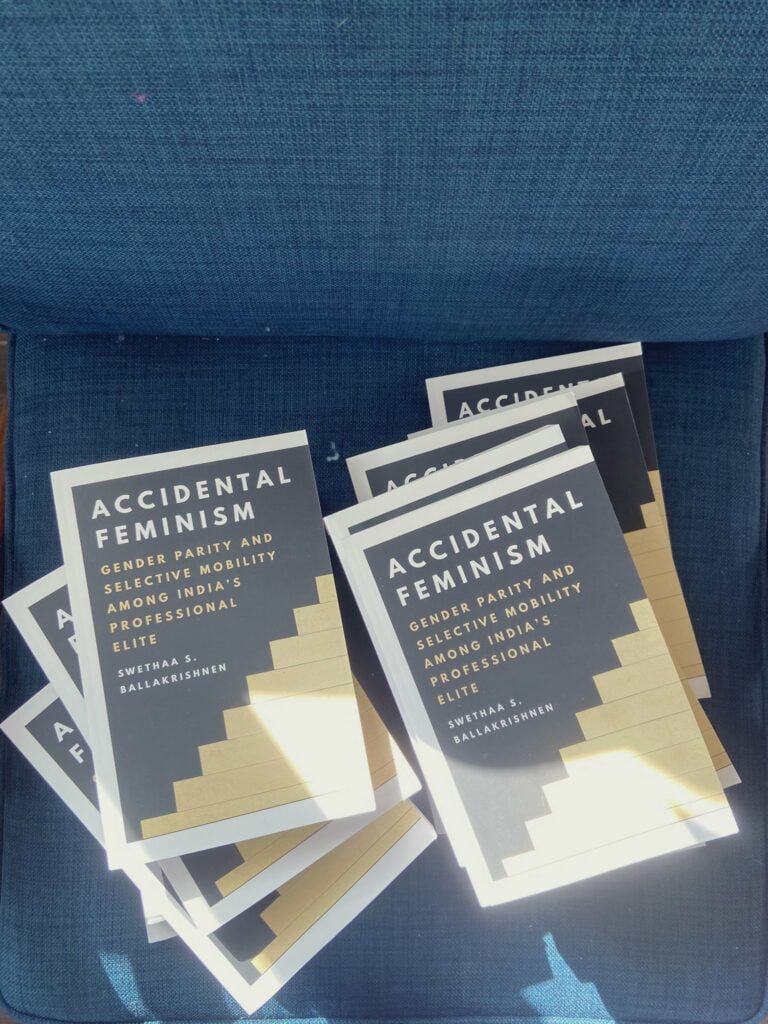In the Preface to their book ‘Accidental Feminism – Gender Parity And Selective Mobility Among India’s Professional Elite’, author Swethaa S. Ballakrishnen asks a very interesting question, ‘Can Feminism be Accidental?’. Through the research for their book, the author chanced upon certain surprising findings- “when the experiences of women in elite law firms are juxtaposed with those of their peers in other similarly elite professional sites, the law firms show unexpected levels of gender parity”.
This is a curious case and the author explores this further in their work to understand how in certain organisations, which are not perhaps intentionally feminist, a range of factors “come together to do gender differently”. The book asks its readers to consider what can be done when such ‘accidental’ instances produce “good” equitable results. What is the importance then of ‘intention’ in equality movements and therefore, can we have different new ways of thinking about such movements and their consequences?
“The advantage that is enjoyed by a particular demographic of women professionals – and across contexts – is predicated on the lives and labour of other much less advantaged women. The book uses a comparative framework of different professionals to show how that these advantages alone were not enough – since not all women with caste and class advantages were similarly capable of navigating professional work in this way – but heeding a finding like this without caution would undo the very premise of calling attention to this phenomenon.“
Swethaa S. Ballakrishnen
Despite the book being essentially academic in nature, the author’s fluid writing draws in even the general readership of the book to think about such concepts differently and in that very process itself perhaps lies the semblance of an answer towards an optimistic future.
Also read: ‘Hood Feminism’ By Mikki Kendall: A Book That Contemplates The True Essence Of Feminism
Swethaa S. Ballakrishnen is a Professor of Sociology, Asian American Studies, and Criminology, Law and Society at the University of California, Irvine. They are also an affiliated faculty at Harvard Law School’s Center on the Legal Profession. On Tuesday, the 8th of November, the New India Foundation announced that, five books have been shortlisted for the 5th Kamaladevi Chattopadhyay NIF Book Prize 2022 that recognizes and honours outstanding non-fiction writings on modern and contemporary India.

Swethaa S. Ballakrishnen’s 2021 book, published by Princeton University Press, is one among the five books shortlisted and they sat down with FII for a conversation concerning their book and the thinking and work that went behind it.
Q. How did the idea for this book first emerge? When did you first realise you wanted your research to become a book?
I was a doctoral student in sociology when I started work on this research – now more than a decade ago – and about a year into the process I knew that this was a book project (rather than a set of articles, for example, which is an increasingly popular model for dissertations). But the actual transition between the idea/hope/dream of this being a book and it actually being out in the world (in 2021, twelve years after I started my PhD!) was much longer and more involved. In my book’s long methods and acknowledgment sections I try to trace some of this journey and thank the many humans and circumstances that made it possible.
Q. The idea ‘accidental feminism’, as you have written in the introduction to your book, can be a powerful theoretical tool in further research by scholars within the fields of law, gender, and the increasing effects of liberalisation and globalisation. Do you feel a knowledge of this idea in other avenues of practical life can be helpful in certain ways?
When I was in graduate school I was really attracted to Cecilia Ridgway’s concept of the background framework – which is the idea that even when we don’t think about it, diffuse notions of gender (and a range of other identity categories, one could argue) shape our interactions and individuations. Part of this book’s agenda is to work with that logic a bit counterintuitively. Unintended extensions and consequences of these frameworks are usually harmful and disadvantageous.

“When I said this book was written primarily for an American scholarly audience, I was clarifying that many of the debates that the book tries to make an intervention within fields that I was trained in – producing what I call disciplinary agoraphobia in the book. And this clarification felt important particularly as I was contrasting it with the vast field of scholarship I don’t mean to speak ahead of (literature that I owe such a debt to, as I unpack in my book’s preface) and my own other work that has focused on different kinds of questions more committed to India’s contemporary law and gender debates.“
Swethaa S. Ballakrishnen
But witnessing sparks of progress without active intention or agentic structural intervention – which is what, as I argue, buttressed the advantages of a particular set of professional women – turns that idea on its head. What do we do, this book asks, when unintentional consequences are not negative? I think beyond theoretical possibility there is a subversive potential that this question has for more practical action. But what is clear is that such practicality, unlike the background framework before it, demands intention. As the last chapter argues– it is not the accident itself, but what we do with it, that matters.
Also read: Book Review | Mapping Dalit Feminism: Towards an Intersectional Standpoint By Anandita Pan
Q. You have mentioned in another interview that you primarily intended the book for an American scholarly audience but to your surprise the book has also been read by others outside the legal academic field. How do you feel about that?
I am grateful to those who have engaged with the book – one of the great rewards of letting an idea out in the world is having a range of people interact with it, not always knowing the – accidental – paths that could emerge from such connection. At the same time, I want to be cognizant of the coordinates of this book and the limits produced by the fact that it was written from data collected when I was in grad school in the United States about very specific questions and poised to face a particular initial audience of academic peers and communities.

“I started data collection over a decade ago with excitement for this surprise gender finding (which was unique across geographic and professional contexts around the globe in different ways), and by the end of the process, it was more complicated apprehension than research clarity. It is some of that messiness between these categories of success and failure that this book tries to work through.“
Swethaa S. Ballakrishnen
When I said this book was written primarily for an American scholarly audience, I was clarifying that many of the debates that the book tries to make an intervention within fields that I was trained in – producing what I call disciplinary agoraphobia in the book. And this clarification felt important particularly as I was contrasting it with the vast field of scholarship I don’t mean to speak ahead of (literature that I owe such a debt to, as I unpack in my book’s preface) and my own other work that has focused on different kinds of questions more committed to India’s contemporary law and gender debates (e.g. my book Gender Regimes with Kalpana Kannabiran, published around the same time as Accidental Feminism by Zubaan).
Q. If the models of these elite law firms and the four factors, which you have mentioned go into certain instances of gender parity, are replicated by other workplaces in the country, do you think it would have the same results?
I think the whole takeaway – and frustration – of the book is that a range of factors, not meant to actually do gender differently in workspaces, came together to produce a relatively positive outcome; and that although it was not without costs, the process itself was marked by its relative blasé attitude towards intentional gender progress. The same set of factors – and recall, timing is one of these factors – could not have come together to do this in any of the other sites in question (and this is where the comparative study in the book offers sharp relief about the uniqueness of the case) and its non-replicability meant that it is not likely to be a “quick fix”.
Also read: Transnational Feminism: An Intersectional, Collaborative, Reflexive Approach To Feminism
The suggestion, instead, is a call to pay attention to the factors that might be doing different work than we initially assume. And that curiosity and attention to the hyperlocal could have benefits across work contexts. Essentially – what is working that we assume is flawed and where are the points of tension despite intention (and how do we pay attention to both as we build newer and more equitable systems).
Q. In the process of research for this book, have you come to a more hopeful conclusion about the future of gender parity in workplaces or are you doubtful and cautious about the model you have described to have inherent flaws of its own? With changes occurring constantly, do you feel this gender parity in these professional elite law firms is sustainable in the long run?
There are no flawless solutions. As Chapter 5 elaborates, so much of what looks like success in only the level of analysis is just a way in which inequality thrives in plain sight. The advantage that is enjoyed by a particular demographic of women professionals – and across contexts – is predicated on the lives and labour of other much less advantaged women.
The book uses a comparative framework of different professionals to show how that these advantages alone were not enough – since not all women with caste and class advantages were similarly capable of navigating professional work in this way – but heeding a finding like this without caution would undo the very premise of calling attention to this phenomenon.
As I say in my introduction, I started data collection over a decade ago with excitement for this surprise gender finding (which was unique across geographic and professional contexts around the globe in different ways), and by the end of the process, it was more complicated apprehension than research clarity. It is some of that messiness between these categories of success and failure that this book tries to work through.
Also read: ‘My Tryst With Feminism In Three Acts’: A Personal Story Of Building A Relationship With Feminism
Q. And lastly, the shortlist for the Kamaladevi Chattopadhyay NIF Book Prize of 2022 has been released. How does it feel to be a part of this prestigious list of five books?
I never forget that in this mercurial academic universe, my book could have easily been a dissertation collecting dust, read again by nobody beyond my committee. I will never stop being surprised and grateful that it gets to, instead, be read by people I don’t know, or that they might give my ideas some real estate in their own thinking process, and I certainly will never stop being struck that it sits alongside such a distinguished array of writers and thinkers on this shortlist.
About the author(s)
Sayeri Biswas recently graduated with a bachelor’s degree in English from St. Xavier’s College, Kolkata. Whether it’s philosophically
contemplating life or gushing about the most recent book/series she has indulged in, she is always up for a deep conversation. Literature is the great love of her life, and in the future, she hopes to continue talking about all art forms as passionately as she thinks
about them.




